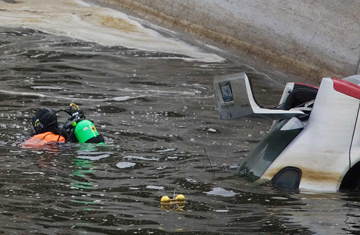
Rescue divers search for victims of the collapsed bridge in Minneapolis, Minnesota.
In the days after the Interstate 35W bridge collapse claimed the lives of at least five people and injured more than 100, rescue divers are taking every precaution to make sure they don't join the tally of victims of the greatest disaster in modern Minnesota history. Shattered glass, gasoline from vehicles, and concrete and reinforcement bars from the fallen bridge provide a host of hazards for divers. And with visibility extending no more than six inches at times, the chances of divers' snagging and skewering themselves on the wreckage is high. On Saturday, rain was added to the mix.
"We can stand a little rain," said Hennepin County Sheriff Rich Stanek at a briefing, "What we can't stand is lightning." He said, however, that wind may be an additional problem because the remains of the bridge remain unstable. There were also "power line issues" upriver. Recovery efforts continued despite the weather and the poor visibility.
But with the range of vision so poor, the divers have to use what one rescue official referred to as the "Braille method" of search, physically feeling their way through the water. Capt. Bill Chandler of the Hennepin County Sheriff's Department supervises the rescue divers, a group of 20 people from several locales, working in groups of three: one person in the water while the other two provide backup. The divers, he said, use sonar to identify potential submerged vehicles. They then carefully make their way to the target and identify what it is.
Crews were focused on 13 areas on the upstream side of the collapse, Stanek said. Officials said there may be vehicles crushed under the main section of the collapsed bridge, which lies in the middle of the river. If this is the case, the large chunks of debris will have to be lifted to reach them, Stanek said.
The debris just makes things worse. "It stirs things up so bad. The visibility's terrible," says Capt. John Grant, a member of the Dakota County (Minn.) Sheriff Department's dive team, one of several groups assisting in the effort. Indeed, officials are sending crews into the river cautiously. Said Stanek: "The divers will be taking extreme caution. We have to be slow and methodical during our search operations."
Grant has participated in missions farther south in the Mississippi River, but he said this one is different. "The visibility is probably worse than it's ever been," he said. "It's very easy to become disoriented." Grant has had 15 years of rescue and recovery experience, yet he says that finding bodies is no less surreal. "It's quiet down below the surface, you don't have the elements of noise from above," he says. So, he adds, "When you find a dead body below the water, it's a little nerve-racking but you know you have a job to do and you have to recover that body." The last official estimate had eight people still missing. But on Saturday authorities were hesistant to address that figure.
Despite training dive crews for a multitude of scenarios, Chandler said he's never seen anything of this magnitude. "We train for all various types of diving but we've never put all of them together in one spot like we have now," he said. "In all my years of diving experience, I never have experienced the conditions we're in now." Says Chandler, "I worry about the guys down there."
Progress is slow and there is no foreseeable end in sight. Chandler says recovery operations will not cease until the job is done. "It may take a long time, but eventually this river will be clear," he says. "We will not be leaving victims behind, we will not be leaving cars behind. No matter how long it takes, this river will be cleared out."
— With reporting by Tiffany Clements and Karlee Weinmann
